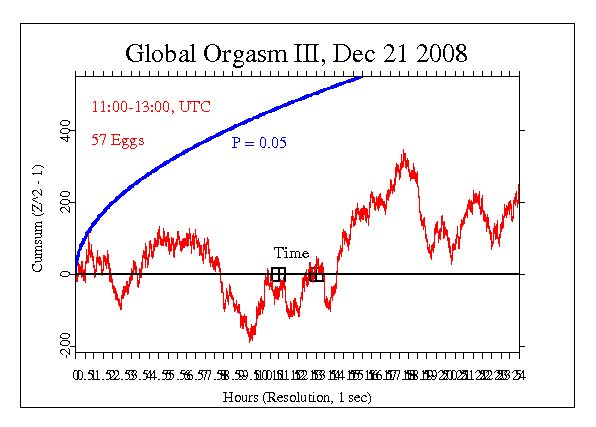|
The third annual Global Orgasm for Peace day was held on Dec 21, 2008.
and we decided again to make a formal prediction for it as
we did in 2006.
Here is the description and invitation:
The organizers of the Global Orgasm, evolutionary
behaviorists Donna
Sheehan and Paul Reffell, would like everyone to synchronize
their greatest surge of physical and spiritual power on the
Solstice,
December 21st, between the hours of 11 a.m. and 1 p.m.
Greenwich Mean Time.
The theory is that if enough people can experience orgasm in
the same time frame while projecting a conscious intention for peace and
harmony on the planet, a surge of physical and spiritual
positivity will infuse the Earth's energy field.
"We're going to zap The Field with joy and put a smile on
the world's faces," enthused Reffell.
Any measurable effects will show up at The Global
Consciousness
Project (http://teilhard.global-mind.org) in Princeton, NJ,
which runs
a network of Random Event Generators around the world, which
record
changes in their randomness during global events. The
results show
that the physical effects of human consciousness can be
measured.
We know that single events don't yield interpretable
outcomes because the signal to noise ratio in the GCP data
is much too small. The average effect size suggests that we
need two dozen or more
events of a similar nature to support reliable
interpretations. Nevertheless this is an interesting event
in principle, so we will are accumulating a suitable
database.
Although the Global-O organizers were clear that the focal
time would be 11:00 to 13:00 GMT,
the formal event time was specified as the
whole day of the 24th, in UTC time.
The Stouffer Z analysis shows a
positive outcome, but it is a mild trend, with a terminal
Z-score of about 0.6 (twice the average Z for the
full database), and probability p = 0.262.
The event time is marked in the graph, and inspection shows
that if we looked only at this segment, we would see a
small positive outcome.
As was the case in previous years, the picture has
a feeling of promise, but the low signal
to noise ratio makes it impossible to determine whether
the trend is evidence of a "signal". On a more positive
note, this is a similar pattern to the previous years, and
it has
approximately the same effect size. We asked last year "will this
pattern continue?" and the record thus far suggests we
should stay tuned.

|